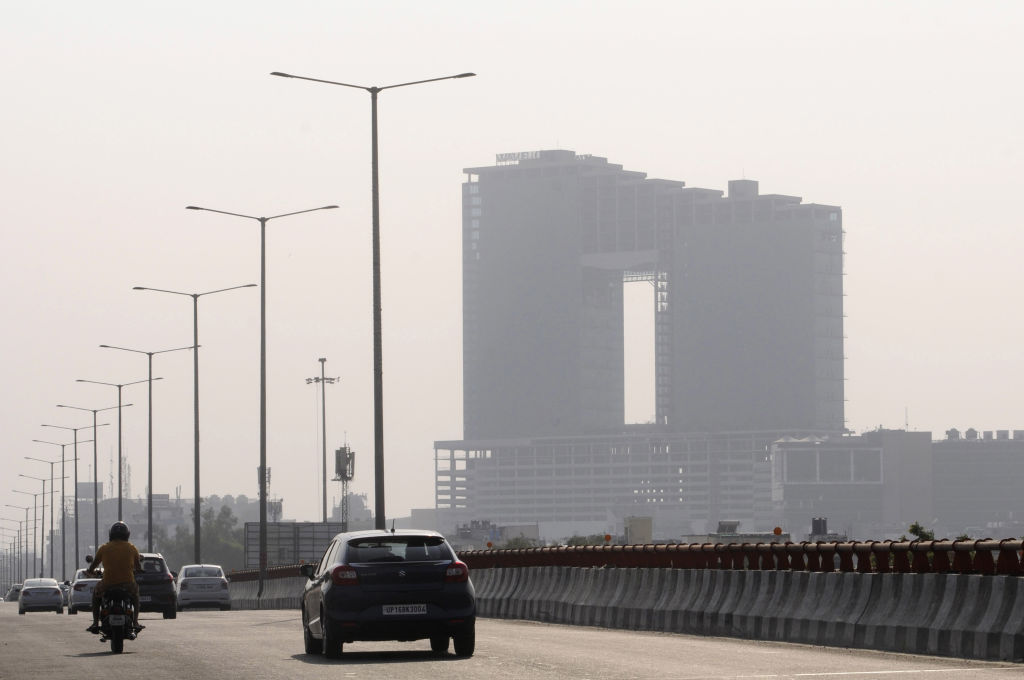Delhi and its adjacent areas were blanketed in haze on Tuesday, marking the fourth consecutive day of very poor air quality in the capital.
According to data from the Indian Institute of Tropical Meteorology, vehicular emissions (11% to 15%) and stubble burning (7% to 15%) were identified as the primary contributors to the city’s deteriorating air quality. Pollution sources in Gautam Buddha Nagar, Uttar Pradesh, were also found to be responsible for up to 14% of the air pollution in Delhi.
At 10 am, the city’s average Air Quality Index (AQI) stood at 350, the highest recorded this season.
The data also indicated that sources of pollution in Gautam Buddha Nagar, Uttar Pradesh, are responsible for up to 14% of the overall air pollution levels in Delhi. The city’s Air Quality Index (AQI) reached a peak of 350 at 10 a.m., marking the highest reading so far this season.
This follows previous daily averages of 347 on Monday, 325 on Sunday, 304 on Saturday, and 261, categorized as ‘poor,’ on Friday. These readings contrast with AQI levels of 256 on Thursday, 243 on Wednesday, and 220 on Tuesday.
Specifically, areas like Rohini and Mundka registered alarmingly high AQI levels, placing them in the ‘severe’ category, with readings exceeding 400. Neighboring regions also grappled with deteriorating air quality, with AQI levels at 232 in Ghaziabad, 313 in Faridabad, 233 in Gurugram, 313 in Noida, and 356 in Greater Noida.
The air quality index, categorized from good to severe, has plunged into the ‘very poor’ range, primarily due to sluggish wind speeds at night and a decrease in temperatures. The Centre’s Air Quality Early Warning System for Delhi predicts that these unfavorable conditions are likely to persist for several more days.
Notably, the air quality in Delhi for October 2023 has exhibited a more pronounced decline compared to the last two years, with meteorologists attributing this trend to the lack of rainfall in the region.
To address this growing crisis, Delhi Environment Minister Gopal Rai has called for the central government to impose a strict ban on buses operating with poor-quality diesel in the National Capital Region (NCR), spanning Haryana, Uttar Pradesh, and Rajasthan. As per directives issued by the Centre’s Commission for Air Quality Management (CAQM), only electric, CNG, and BS VI-compliant diesel buses will be permitted to operate in the NCR areas surrounding Delhi starting November 1, 2023.
In a concerted effort to combat pollution levels, India mandated in April 2020 that all vehicles sold in the country adhere to the Bharat Stage VI (BS-VI) emission standards. These standards define legal limits for air pollutants emitted by vehicles, encompassing carbon monoxide and particulate matter, while concentrating on enhancing emission control, fuel efficiency, and engine design. This initiative has led to the provision of cleaner fuel by oil companies, recognized as the world’s cleanest fuel.
Unfavourable meteorological conditions and a combination of emissions from firecrackers and paddy-straw burning, coupled with local sources of pollution, have collectively led to hazardous air quality levels in the Delhi-NCR region during the winter season.
A recent analysis conducted by the Delhi Pollution Control Committee (DPCC) revealed that Delhi experiences peak pollution levels from November 1 to November 15, coinciding with an increase in stubble-burning incidents in the states of Punjab and Haryana.
The Commission for Air Quality Management, a statutory body responsible for devising strategies to mitigate pollution in Delhi-NCR, announced a substantial reduction in the number of stubble-burning incidents in Punjab and Haryana since September 15. The reduction stands at approximately 56% in Punjab and 40% in Haryana, compared to the same period in the previous year.
From September 15 to October 29, the cumulative number of farm fires in Delhi, Punjab, Haryana, and NCR areas of Rajasthan and Uttar Pradesh diminished from 13,964 in 2022 to 6,391 in 2023.
In Punjab, there were 5,254 stubble-burning incidents during this 45-day period in 2023, significantly lower than the 12,112 incidents in 2022 and 9,001 in 2021, representing reductions of 56.6% and 41.6%, respectively. Haryana also reported a substantial reduction in stubble burning cases during the same period, with 1,094 cases in 2023, compared to 1,813 in 2022 and 2,413 in 2021, reflecting reductions of 39.7% and 54.7%, respectively.
The Punjab government is on a mission to reduce farm fires by 50% this winter season, with plans to eliminate stubble burning in select districts. These include Hoshiarpur, Malerkotla, Pathankot, Rupnagar, SAS Nagar (Mohali), and SBS Nagar. The state’s action plan outlines the management of paddy straw through in-situ and ex-situ methods.
Haryana, on the other hand, estimates that around 14.82 lakh hectares of land in the state are dedicated to paddy cultivation, expected to generate over 7.3 million tonnes of paddy straw. The state is actively pursuing near elimination of farm fires in the upcoming season.
Taking a proactive stance, the Delhi government unveiled a 15-point action plan last month to combat air pollution during the winter season, emphasizing efforts to address dust pollution, vehicular emissions, and open burning of garbage.
In keeping with previous practices, the Delhi government recently imposed a comprehensive ban on the manufacture, storage, sale, and use of firecrackers within the city, aimed at mitigating pollution levels during the winter months. (With inputs from PTI)





